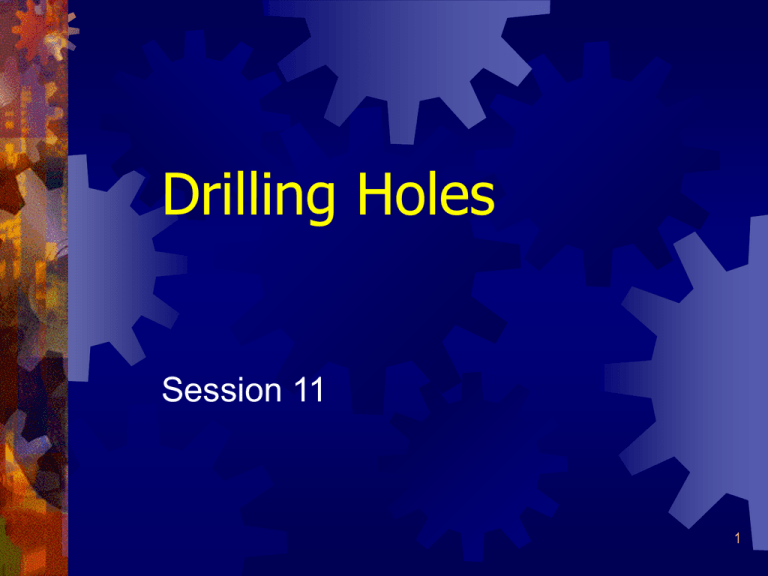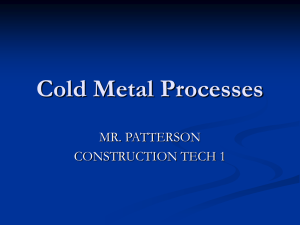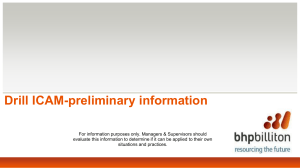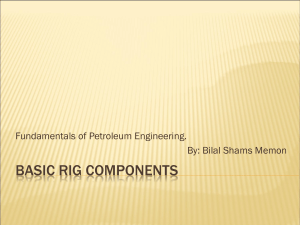Drilling Holes - Skilled Trades Math On-line
advertisement

Drilling Holes Session 11 1 Drill Press Safety 1. Do not operate before understanding operation including how to stop 2. Always were approved safety glasses 3. Never attempt to hold work by hand 4. Keep your head back from revolving parts 5. As drill begins to break through work, ease up on drill pressure 2 Drill Press Safety 6. Always remove burrs from drilled hole with file or deburring tool 7. Never leave chuck key in drill chuck 8. Never attempt to grab work that may have caught in drill • Stop machine first 9. Always keep floor around drill press clean and free of tools, chips, and oil 3 Drilling Hints 1. Treat cutting tools with care 2. Always examine condition of drill point before use – do not use dull tools 3. Make sure drill point angle correct for type of material to be drilled 4. Set correct revolutions per minute for size of drill and workpiece material 4 Drilling Hints 5. Set up work so drill will not cut into machine as it breaks through workpiece 6. Work should always be clamped securely 7. End of workpiece farthest from hole should be placed on left-hand side of table so it will not swing toward operator 5 Drilling Hints 9. Use shortest drill Always clean tapered drill shank, sleeve, and machine spindle before inserting drill 10. length possible and/or hold it short in chuck 10. Good practice to start each hole with center drill • Provides guide for drill to follow 6 Drilling Hints 11. Thin workpieces should be clamped to hardwood block for drilling 12. Chips from each flute should be same shape; if blue during drilling, check drill point condition 13. Drill squeak usually indicates dull drill 7 Drilling Hints 14. When increased pressure must be applied during drilling, reason usually dull drill or chip caught in hole between drill and work 8 Determining Size of a Drill • Good practice to always check drill for size before drilling • Checking for size • Drill gage • Micrometer • Most accurate • Check measurement across margin of drill 9 Spotting Hole Location With a Spotting Drill • Chisel end on drill wider than centerpunch mark on work • Spot center-punch mark with spotting drill Small point on spotting drill will accurately follow center-punch mark and provide guide for larger drill 10 Spotting Hole Location With a Spotting Drill 1. 2. 3. 4. Mount small-size spotting drill Mount work in vise Set drill speed to 1500 r/min Bring point of spotting drill into centerpunch mark and allow work to center itself with drill point 5. Continue drill until proper diameter has been produced 6. Spot all holes to be drilled 11 Spotting Hole 12 Drilling Work Held in a Vise 1. Spot hole location with spotting drill 2. Mount correct-size drill in drill chuck 3. Set drill press to proper speed for size of drill and type of material to be drilled 4. Fasten clamp or stop on left side of table 5. Mount work on parallels in drill vise and tighten it securely 13 Drilling Work Held in a Vise 6. With vise against table stop, locate spotted hole under center of drill 7. Start drill press spindle and begin to drill • • Holes up to ½ in. – hold vise against table Holes over ½ in. – Clamp vise to table • • Drill until full drill point into work With drill revolving, deep drill point in work and tighten clamp holding vise 14 Drilling Work Held in a Vise 8. Raise drill occasionally to break the chip 9. Apply cutting fluid during drilling 10. Ease up on drilling pressure as drill starts to break through workpiece 15 Drilling to a Layout 1. Clean and coat surface with layout dye 2. Locate position of hole from two machined edges of workpiece and scribe lines 3. Lightly prick-punch where two lines intersect 4. Check accuracy of punch mark 16 Drilling to a Layout 5. Spot drill work to just beyond depth of drill point 6. Mount proper size drill in machine and drill hole to depth 17 Drilling With Large Drills • Drills increase in size; thickness of web also increases to give drill strength • Thicker web, thicker point of drill • Thick web won’t follow center-punch mark easily • Two methods to overcome poor cutting action of thick web on large drills • Web is thinned • Lead, or pilot, hole is drilled 18 Pilot Holes • Drill pilot hole diameter which is slightly larger than thickness of web Care must be taken to drill pilot hole on center Pilot hole then followed with larger drill Problems when pilot hole too large • • • • • • Cause chattering Drill hole out-of-round Spoil top (mouth) of hole 19 Drilling with Pilot Holes 1. Check print and select proper drill 2. Measure thickness of web at point • Select pilot drill with diameter slightly larger than web thickness 3. Mount workpiece on table 4. Adjust height and position of table so drill chuck can be removed and larger drill placed in spindle after pilot hole drilled and lock table 20 Drilling with Pilot Holes 5. Place center drill in drill chuck, set proper spindle speed, accurately drill center hole 6. Using proper-size pilot drill, drill pilot hole 7. Shut off machine, leaving pilot drill in hole 8. Clamp work securely to table 9. Raise drill spindle, remove drill and chuck 21 Drilling with Pilot Holes 10. Clean taper shank of drill and spindle hole 11. Mount large drill in spindle 12. Set spindle speed, feed and drill hole to required depth 22






